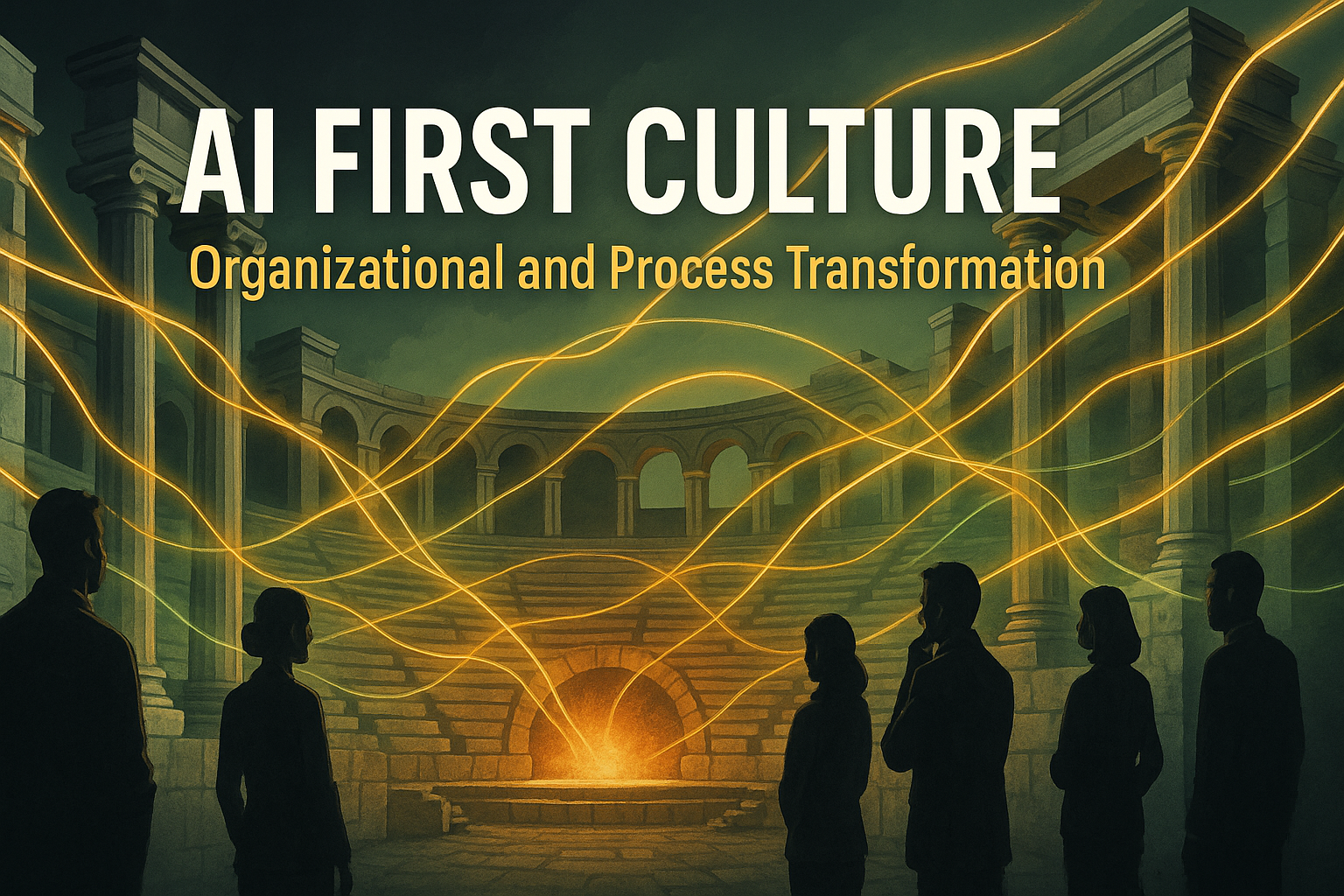
AI First Culture: Organizational and Process Transformation
By Derek Neighbors on August 27, 2025
I’m standing in a conference room watching a 20-year veteran engineer, someone I respect, dismiss AI code review after trying it once: “Got copypasta garbage. Would take me 30 minutes to do it right myself.” Meanwhile, the startup down the hall is shipping features 3x faster using the exact same tools.
What pissed me off wasn’t his resistance. It was my recognition that I’d done the same thing. Six months earlier, I’d rejected AI assistance because it felt like admitting I wasn’t good enough. The cultural immune system wasn’t just rejecting foreign technology, it was protecting our identity as irreplaceable experts.
I’ve written about this skill issue before, how engineers dismiss AI effectiveness while others achieve 10x productivity gains. But this isn’t just about individual skill gaps. It’s about organizational cultures that reward this dismissal - the same pattern I explored in Stop Changing Your Tactics and Deal With Your Shit where we avoid the real work by focusing on surface-level solutions.
Culture doesn’t just eat strategy for breakfast. Culture will devour your AI transformation, shit out the bones, and ask for seconds.
You can architect perfect systems and engineer flawless processes, but if your people are culturally wired to reject AI-first thinking, you’re building a Ferrari for people who refuse to stop riding horses.
The Pattern of Organizational Antibody Syndrome
This is organizational antibody syndrome, and I’ve been both the antibody and the infection.
Here’s what I’ve learned: Technical capability means nothing when your culture is designed to reject it.
We install the tools, fund the training, celebrate the “AI readiness” initiatives. But we never address the real problem: the executives funding these programs are often the biggest antibodies in the system. They want the competitive advantage without the identity disruption.
We implement the architecture, scale the processes, but we never confront the cultural immune system that’s designed to reject transformation.
The Four Avoidance Patterns
Pattern 1: The Expertise Protection Racket
The Behavior: Subject matter experts hoarding knowledge and resisting AI assistance
I watched a senior data analyst refuse to use AI for pattern recognition because “the model doesn’t understand our industry nuances”, while spending 80% of her time on work AI could handle in minutes. She’d built her identity around being the person who could spot trends others missed. AI threatened that identity, so she found reasons why it couldn’t work.
The Truth: They’re protecting their identity as the irreplaceable expert
The Greek Insight: This violates phronesis (practical wisdom), true expertise knows when to leverage tools for greater impact. The wise person multiplies their capability; the insecure person hoards it.
The Pattern: Expertise becomes a prison when it prevents you from multiplying your capability.
Pattern 2: The Quality Smokescreen
The Behavior: Demanding AI outputs meet impossible standards while accepting mediocre human work
I watched a marketing director reject AI-generated blog posts because they “lacked brand voice authenticity”, then approve human-written content that was objectively worse by every metric: readability scores, engagement rates, even basic grammar. The same director who’d been accepting typo-riddled, deadline-missed content from his team for years suddenly became a perfectionist when AI was involved.
Here’s the brutal truth: I’d done the exact same thing six months earlier. Rejected AI-generated code documentation because it “didn’t capture the nuances” while approving human docs that were incomplete, outdated, and barely functional. I wasn’t protecting quality, I was protecting my identity as the person who understood those nuances.
The Truth: They’re weaponizing quality standards to protect the status quo
The Greek Insight: Arete (excellence) is about elevating capability, not creating barriers to improvement. True excellence embraces tools that raise the baseline.
The Pattern: Perfectionism becomes protectionism when it serves resistance over results.
Pattern 3: The Democracy of Dysfunction
The Behavior: Requiring unanimous buy-in before any AI adoption, giving veto power to the most resistant
I sat through a “Digital Transformation Committee” that spent eight months creating an AI ethics framework while their main competitor automated their core workflow and stole three major clients. The committee chair, a VP who’d never used AI, kept saying “we need everyone aligned before we move forward.”
I know because I was that VP in a previous role. Lost two enterprise clients to a competitor who deployed AI-assisted customer service while I was still running “stakeholder alignment sessions.” The cost of my committee cowardice: $2.8M in annual recurring revenue and the trust of my engineering team, who watched me choose consensus over leadership when it mattered most.
The Truth: They’re using democratic process to distribute accountability into oblivion
The Greek Insight: Andreia (courage) means accepting responsibility for necessary change, not hiding behind consensus. Sometimes leadership means moving forward when others aren’t ready to follow.
The Pattern: Collaboration becomes cowardice when it’s used to avoid leadership.
Pattern 4: The Education Racket
The Behavior: Endless workshops and certifications without actual implementation requirements
A Fortune 500 company spent $2.3 million on “AI Leadership Certification” for 400 executives. Beautiful certificates, comprehensive curricula, glowing satisfaction scores. Six months later, I audited their actual AI usage: less than 8% of certified leaders were using AI tools for anything beyond email summaries.
The Chief Learning Officer called it a “tremendous success” based on completion rates. The CEO called me because they were losing market share to companies that skipped the training and went straight to implementation.
The training was designed to create the appearance of progress without the risk of change. It let executives check the “AI readiness” box without actually becoming AI-ready.
The Truth: They’re funding expensive procrastination disguised as progress
The Greek Insight: Praxis (practice) is where transformation happens, knowledge without application is expensive procrastination.
The Pattern: Learning becomes hiding when it substitutes for doing.
What Actually Works (And Why It’s Harder Than It Sounds)
Here’s what I’ve learned about cultural transformation, and why “brutal simplicity” isn’t always simple:
Culture change happens through consequences, not conversations.
When I finally saw organizations succeed with AI-first culture, it wasn’t because they found perfect change management. It was because they made AI resistance more painful than AI adoption.
Concrete example: A 150-person software company was stuck at 18% AI tool adoption after six months of “training initiatives.” The CTO implemented a simple consequence: code reviews that didn’t use AI assistance were automatically flagged for extended review cycles. Within 30 days, AI-assisted code reviews jumped to 73%. Average PR review time dropped from 2.3 days to 0.8 days. No additional training required.
But here’s where it gets complicated: What works in healthy cultures can backfire in toxic ones.
In healthy cultures, you can make AI-first the path of least resistance. In toxic cultures, the resistance IS the culture, and the leadership often benefits from the dysfunction.
The hard truths I’ve learned:
Stop negotiating with systematic resistance - If your culture rewards avoiding AI, changing individual minds is pointless. You’re fighting the system, not the symptoms.
Start measuring what threatens the resisters - Track AI impact on the metrics that matter to the people blocking change. Make their resistance visible and expensive.
Deal with leadership complicity first - Most “cultural resistance” is actually executive cowardice disguised as employee concern. Leaders who won’t use AI themselves can’t credibly demand it from others.
Accept that some cultures can’t be saved - Sometimes the antibody response is so strong that transformation requires replacement, not rehabilitation. Some organizations would rather die slowly than change quickly.
Make consequences matter: Phronesis (practical wisdom) means measuring what threatens resistance, not what feels comfortable. Focus on clear avoidance behaviors: refusing to try AI tools, dismissing results without iteration, hiding behind process to avoid adoption. The goal is arete (excellence) through capability multiplication.
The 30/60/90 Consequence Design
30 days: Define 2-3 AI adoption KPIs that matter: cycle time reduction, percentage of tasks AI-assisted, or review velocity improvements. Make them visible in weekly team reviews.
60 days: Connect one KPI to a visible operational ritual. Post AI contribution metrics on team dashboards. Celebrate wins publicly, address resistance privately but directly.
90 days: Link AI fluency to decision rights or advancement criteria. AI-assisted work becomes the baseline expectation, not the exception. Non-adoption requires justification, not adoption.
The Cultural Transformation Diagnostic
Before you fund another “AI readiness initiative,” ask yourself the uncomfortable questions:
- What identity am I protecting by avoiding AI implementation?
- What story am I telling myself about why my people “aren’t ready”?
- What would I have to admit if AI actually made my team more capable?
- What am I afraid I’ll discover about my current leadership value?
- How is my focus on “cultural readiness” protecting me from the real work of transformation?
- Who benefits from keeping AI adoption slow and committee-managed?
- What would happen to the current power structure if AI democratized capability?
The answers will tell you whether you’re leading cultural change or subsidizing cultural stagnation.
And here’s the question that separates leaders from managers: Am I willing to make AI resistance a career-limiting move?
If the answer is no, stop pretending you want transformation. You want the appearance of progress without the disruption of change. Real transformation requires metanoia, a fundamental change of mind that starts with your own willingness to be wrong about what you thought leadership meant.
The Challenge: Audit Your Own Complicity
Here’s your challenge: Audit your own complicity in AI resistance
Stop bullshitting yourself:
- Identify YOUR resistance: Where are you avoiding AI-first approaches in your own work?
- Face what you’re protecting: What part of your identity or authority feels threatened by AI democratization?
- Ask the diagnostic questions: What are YOU really afraid of discovering?
- Address your leadership antibodies: How are you rewarding AI avoidance while claiming to promote adoption?
- Make a commitment this week: Pick one area where you’ll make AI resistance a performance issue, not a training opportunity
Don’t change training programs. Change what gets rewarded and what gets punished.
And if you’re not willing to make AI fluency a job requirement, stop pretending you want transformation.
Final Thoughts
This reveals something brutal about organizational leadership, and about me.
I spent $180K on change management consultants to help my team “embrace AI transformation” while I was secretly terrified that AI would expose how much of my leadership value was built on information hoarding and decision bottlenecks. The consultants sold me frameworks for cultural readiness while I funded my own resistance.
The leaders who succeed with AI transformation don’t manage change, they create consequences. They don’t wait for buy-in, they make AI fluency a survival requirement.
Most importantly, they stop pretending that cultural resistance is something that happens TO them. They recognize it as something they’ve been enabling, funding, and rewarding.
The organization that faces this truth never needs another “AI readiness” initiative.
They have something better: Leadership that demands evolution instead of managing stagnation.
That’s the difference between AI adoption pantomime and AI transformation reality.
Challenge: This week, identify one area where you’ll stop rewarding AI resistance and start making it a performance issue. If you’re not ready to do that, you’re not ready for transformation, you’re ready for more expensive learning cosplay.
Ready to stop funding resistance and start demanding transformation? MasteryLab is for leaders who are done subsidizing stagnation. Use the Cultural Transformation Diagnostic in our community forum this week, face the feedback or keep hiding behind “cultural readiness” initiatives that protect your comfort over your company’s survival.




